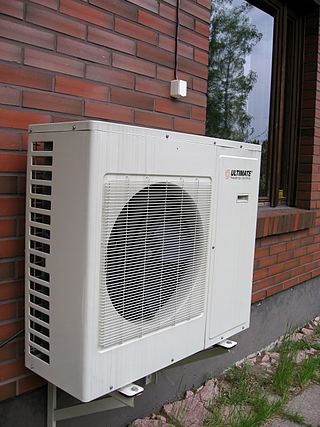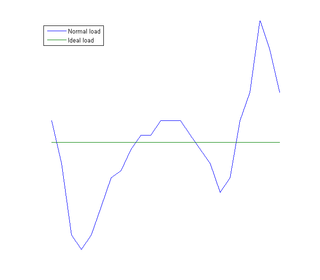
Automatic meter reading (AMR) is the technology of automatically collecting consumption, diagnostic, and status data from water meter or energy metering devices and transferring that data to a central database for billing, troubleshooting, and analyzing. This technology mainly saves utility providers the expense of periodic trips to each physical location to read a meter. Another advantage is that billing can be based on near real-time consumption rather than on estimates based on past or predicted consumption. This timely information coupled with analysis can help both utility providers and customers better control the use and production of electric energy, gas usage, or water consumption.

Energy conservation is the effort to reduce wasteful energy consumption by using fewer energy services. This can be done by using energy more effectively or changing one's behavior to use less service. Energy conservation can be achieved through efficient energy use, which has some advantages, including a reduction in greenhouse gas emissions and a smaller carbon footprint, as well as cost, water, and energy savings.

Water supply is the provision of water by public utilities, commercial organisations, community endeavors or by individuals, usually via a system of pumps and pipes. Public water supply systems are crucial to properly functioning societies. These systems are what supply drinking water to populations around the globe. Aspects of service quality include continuity of supply, water quality and water pressure. The institutional responsibility for water supply is arranged differently in different countries and regions. It usually includes issues surrounding policy and regulation, service provision and standardization.

A central heating system provides warmth to a number of spaces within a building from one main source of heat. It is a component of heating, ventilation, and air conditioning systems, which can both cool and warm interior spaces.

Net metering is an electricity billing mechanism that allows consumers who generate some or all of their own electricity to use that electricity anytime, instead of when it is generated. This is particularly important with renewable energy sources like wind and solar, which are non-dispatchable. Monthly net metering allows consumers to use solar power generated during the day at night, or wind from a windy day later in the month. Annual net metering rolls over a net kilowatt-hour (kWh) credit to the following month, allowing solar power that was generated in July to be used in December, or wind power from March in August.

An electricity meter, electric meter, electrical meter, energy meter, or kilowatt-hour meter is a device that measures the amount of electric energy consumed by a residence, a business, or an electrically powered device.

The Energy Policy Act of 2005 is a federal law signed by President George W. Bush on August 8, 2005, at Sandia National Laboratories in Albuquerque, New Mexico. The act, described by proponents as an attempt to combat growing energy problems, changed US energy policy by providing tax incentives and loan guarantees for energy production of various types. The most consequential aspect of the law was to greatly increase ethanol production to be blended with gasoline. The law also repealed the Public Utility Holding Company Act of 1935, effective February 2006.

Negawatt power is investment to reduce electricity consumption rather than investing to increase supply capacity. In this way investing in negawatts can be considered as an alternative to a new power station and the costs and environmental concerns can be compared.

A smart meter is an electronic device that records information—such as consumption of electric energy, voltage levels, current, and power factor—and communicates the information to the consumer and electricity suppliers. Such an advanced metering infrastructure (AMI) differs from automatic meter reading (AMR) in that it enables two-way communication between the meter and the supplier.

An energy audit is an inspection survey and an analysis of energy flows for energy conservation in a building. It may include a process or system to reduce the amount of energy input into the system without negatively affecting the output. In commercial and industrial real estate, an energy audit is the first step in identifying opportunities to reduce energy expense and carbon footprint.
An energy service company (ESCO) is a company that provides a broad range of energy solutions including designs and implementation of energy savings projects, retrofitting, energy conservation, energy infrastructure outsourcing, power generation, energy supply, and risk management.

Water metering is the practice of measuring water use. Water meters measure the volume of water used by residential and commercial building units that are supplied with water by a public water supply system. They are also used to determine flow through a particular portion of the system.

Load management, also known as demand-side management (DSM), is the process of balancing the supply of electricity on the network with the electrical load by adjusting or controlling the load rather than the power station output. This can be achieved by direct intervention of the utility in real time, by the use of frequency sensitive relays triggering the circuit breakers, by time clocks, or by using special tariffs to influence consumer behavior. Load management allows utilities to reduce demand for electricity during peak usage times, which can, in turn, reduce costs by eliminating the need for peaking power plants. In addition, some peaking power plants can take more than an hour to bring on-line which makes load management even more critical should a plant go off-line unexpectedly for example. Load management can also help reduce harmful emissions, since peaking plants or backup generators are often dirtier and less efficient than base load power plants. New load-management technologies are constantly under development — both by private industry and public entities.
The German income approach is the standard approach used in Germany for the valuing of property that produces a stream of future cash flows.
GridPoint is an American clean technology company based in Reston, Virginia, that provides energy management and sustainability services to enterprises and government agencies, such as electric utilities.
M-Bus or Meter-Bus is a European standard for the remote reading of water, gas or electricity meters. M-Bus is also usable for other types of consumption meters, such as heating systems or water meters. The M-Bus interface is made for communication on two wires, making it cost-effective. A radio variant of M-Bus Wireless M-Bus is also specified in EN 13757–4.
Energy Management Software (EMS) is a general term and category referring to a variety of energy-related software applications which may provide utility bill tracking, real-time metering, building HVAC and lighting control systems, building simulation and modeling, carbon and sustainability reporting, IT equipment management, demand response, and/or energy audits. Managing energy can require a system of systems approach.
The open metering system of the Open Metering System Group e.V. stands for a manufacturer- and media-independent standardization for Meter-Bus (M-Bus) based communication between utility meters, submetering, and systems in the field of smart meters.
ASU Campus Metabolism is a website managed by Arizona State University, demonstrating Energy monitoring and targeting through use of real-time and historic energy use data of buildings on the campus in Tempe, Arizona. The site displays data from an Energy Information System in order to support education, research, operations and outreach regarding sustainability of operations on the ASU Tempe campus. The site is part of a plan for the campus to be carbon-neutral by 2025.
Energy efficiency, or efficient energy use, describes an optimization of the power requirements and environmental impacts of energy systems. This includes actions taken by a governing body to decrease power use over an entire power grid, or actions taken by individuals to make their energy use in their house less wasteful. It is also one of the easiest and most cost effective ways to fight climate change and air pollution.















